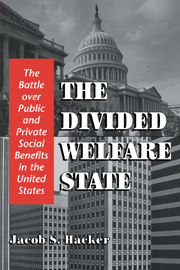Book contents
- Frontmatter
- Contents
- List of Tables
- List of Figures
- Preface
- Part I The American Welfare Regime
- Introduction: American Exceptionalism Revisited
- 1 The Politics of Public and Private Social Benefits
- Part II The Politics of Public and Private Pensions
- Part III The Politics of Public and Private Health Insurance
- Part IV The Formation and Future of the American Welfare Regime
- Appendix
- Notes
- Index
1 - The Politics of Public and Private Social Benefits
Published online by Cambridge University Press: 05 June 2012
- Frontmatter
- Contents
- List of Tables
- List of Figures
- Preface
- Part I The American Welfare Regime
- Introduction: American Exceptionalism Revisited
- 1 The Politics of Public and Private Social Benefits
- Part II The Politics of Public and Private Pensions
- Part III The Politics of Public and Private Health Insurance
- Part IV The Formation and Future of the American Welfare Regime
- Appendix
- Notes
- Index
Summary
Social policies vary in many ways. They are centralized or decentralized, targeted or inclusive, costly or inexpensive. They use different mechanisms, deliver different benefits, address different problems, embody different strategies. Any theory that tried to capture all, or even most, of these differences would prove not just unwieldy but practically useless. In the 1960s, for instance, the economist E. S. Kirschen and his colleagues identified sixty-three distinct policy instruments in their exhaustive (and exhausting) three-volume study, Economic Policy in Our Time. Needless to say, as an effort to reduce policy to its essence, this particular exercise left much to be desired.
The intricacies of the terrain should not, however, scare off the aspiring topographer. A map of complex reality, after all, is inevitably a simplified representation that captures only those features of the landscape most relevant to those who will use it as a guide. The goal of this chapter is to present a unified framework for understanding the political development of public and private social benefits in the United States. My aim, therefore, is not to catalog all of the ways in which alternative policy approaches might differ, but to single out a few of the most important differences that both theory and common sense suggest should influence the politics and evolution of social policy.
The exposition proceeds in three stages. First, I step back from the larger issues raised in the last chapter to ask a simple question: In what politically relevant ways do alternative social welfare approaches differ?
- Type
- Chapter
- Information
- The Divided Welfare StateThe Battle over Public and Private Social Benefits in the United States, pp. 28 - 66Publisher: Cambridge University PressPrint publication year: 2002

